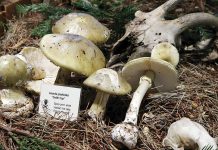Preparing for pandemic flu needs to start now
Preparing for pandemic flu needs to start now
San Benito educators received a flood of information on pandemic flu this week “We are working on a county plan as we speak and hope to have it done by the end of this month,” said Samela Perez, a public information officer for the public health division, during a summit sponsored by the San Benito County Public Health Division and the County Office of Education. “We are here to help [schools] in developing their own plans.”
More than 70 educators showed up for the multipurpose summit, some coming from as far away as Bitterwater. At the summit, the public health division explained the differences between seasonal influenza, bird or avian influenza and pandemic influenza – sometimes a confusing distinction. They also brought a panel of speakers who all play a role in health or emergency preparedness in the county. The summit brought educators together with health officials to get them talking about what needs to be done before pandemic flu hits San Benito County.
“We’ve never had a meeting like this,” said Liz Falade, the county’s health officer. “We want to have a sense of humor even though it’s something to be taken seriously.”
Though Falade said a pandemic flu is likely at least two years away if not farther out on the horizon, the time to prepare is now.
To break the ice at the summit, Perez – one of many county employees who helped plan the event – played a video called “Why don’t we do it in our sleeves?” The video scored people on best sneezes and coughs, explaining that sneezing into a sleeve is actually a better way to stop the spread of germs than sneezing into one’s hands or a tissue when done properly.
Influenza breakdown
For the rest of the morning, educators gathered around tables rated each sneeze and cough. Despite the jovial atmosphere, the teachers took the information seriously.
The first lesson explained the difference between seasonal influenza and pandemic influenza. Compared to the numbers infected by pandemic influenza that can be 30 to 40 percent of the population, few people are infected by seasonal flu.
“When you say you feel crummy, you say you have the flu but most people really don’t,” Falade said. “We don’t do tests to see if it is really flu or not.”
Avian or bird flu is a virus that has received much press in recent years because health experts view it as a virus that could mutate to spread easily among humans – causing a pandemic.
“Avian or bird flu, is not the same as human influenza or pandemic influenza,” Falade said, adding that most human cases of avian flu that have been diagnosed are in people who work closely with infected birds such as poultry.
“This is probably where it will start,” Falade said. “We are concerned because it seems to be more pathogenic and that is concerning if it jumps species.”
Pandemic flu is a regular occurrence and three pandemics spread across the world in the 20th century. The most fatal was the 1918 Spanish flu. Like avian flu, the Spanish flu originated in birds.
Unlike seasonal influenza, which hits the young and old hardest, a pandemic influenza would be a flu virus that the human population has not been exposed to before. Without exposure, few people would have immunity to it, regardless of age, Falade explained.
The highest fatality rate during the 1918 pandemic were people in their 20s.
Flu vaccines currently on the market would provide no protection against pandemic flu and experts estimate it would take six to eight months after a pandemic hit to develop such a vaccine, Falade said. Antiretroviral drugs such as Tamiflu are limited in availability and a new virus could be resistant to them.
The goal for pandemic flu – since health experts cannot stop one – is to lessen its impact.
Schools are an especially important part of the puzzle in controlling the spread of any illness because schools put children into close contact with each other. Children are often the first to be exposed to an illness and to bring it into the home, in turn spreading it to family members.
“If we push the pandemic curve out far enough we will have something to offer people so they don’t get sick,” Falade said.
Community resources
A panel of six community members shared their role in preparing for pandemic flu as well as ways they could help schools. The panelists included county employees and members of the community that will serve as a resource while preparing for pandemic influenza.
“People will need to be in their homes for at least two weeks so we need to prepare for more than 72 hours,” said Lynda Maguet, the disaster services director for the Monterey-San Benito chapter of the American Red Cross. “We have brochures on sheltering in place.”
The agency is looking at ways to provide their regular disaster services in a way that would not bring people in contact with each other.
Another panelist, Karen Aeschliman, a registered nurse who works in Hazel Hawkins’ infection control department, said the hospital is on par with other major hospitals when it comes to dealing with contagious illnesses.
“We are fortunate to have an infectious disease physician in a small community,” she said. “We are right in line with most other, even large, hospitals. We are a whole lot more prepared than we were three to four years ago.”
In the last hours of the summit, the educators broke into groups of six with one health professional per group to discuss a scenario and how local schools should handle it. In the scenario, pandemic flu spreads from a few isolate cases in Los Angeles to cases in San Benito in a matter of days.
The exercise brought up questions about closing down schools, fielding calls from panicky parents and how to handle the shut down of lunch services if vendors weren’t available to make deliveries.
“This is the type of dialogue we need to be having,” said one group leader. “We need to be thinking about emergency kits and talking about how the public health division could help.”
While each group discussed the hypothetical steps they would take for the scenario, most emphasized preparation as the key and most admitted their schools were far from prepared now. The public health division gave out a binder with information on preparation to each educator based on information put together by the San Mateo public health department.
The county is planning summits with local business owners and other groups in the future to start a similar dialogue.
“We will need to be having drills and practices,” Falade said. “If it hits, its not forever but we need to have the big picture. People may be wearing masks and staying home sick.”
For more information on pandemic flu preparation, visit www.sanbenitoco.org or www.pandemicflu.gov.









